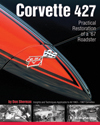|
Corvette 427
by Don Sherman
Price: $49.95
|

Vette ? January 2001
Corvette 427 review from Vette ? January 2001
"If you have ever read a restoration guide or service manual while trying to refurbish your own project Corvette, you will be quick to notice that while the guide may be informative, the information may not be particularly easy to comprehend or to put into use. Renowned automotive writer and experienced auto restorer Don Sherman has knocked down the barrier of typical restoration manuals by offering his restoration guide in the form of a story, the author's hands-on experiences gleaned from the restoration of his '67 big-block convertible.
As you follow along through the text, photos, and captions, you'll really get a feel for what goes into the painstaking task of restoring a Corvette. While the primary focus of the book is on the restoration of a '67 427 Corvette, the insights and techniques (such as rebuilding the suspension, steering, and brakes) apply in most instances to all '63-67 Corvettes and, for the most part, '68-82 third-generation Vettes.
After I finished reading the Practical Restoration of a '67 Roadster, I was convinced that this book would be an inspiration for the restoration of not just a Corvette of any year, but almost any make or model car. I really felt as though I was restoring the car with Don, and I could sense the love and sheer determination as well as all of the time, organization, and money that is required to bring a classic Corvette "up to snuff."
The author gives plenty of tips and techniques along with his opinions on what works and what doesn't fit properly. He started out with a '70s era, custom, complete with a hideous spaghetti-striped hood, a duck-tail spoiler, and a pair of high-back bucket seats out of who knows what, which made for one sick puppy. The chapters touch on everything from how he removed the bonded-on rear spoiler to the hardships that can happen when having the car shipped by a public carrier?and how severs the damage that an incompetent carrier causes can be.
Some of the important points brought up in many of the chapters include how to properly support the body when it is removed from the frame, what to do when the expensive new reproduction parts don't fit, and the frustrations that are associated with having to do a job over several times. The author walks you through his organization process, discusses the errors he made, and tells you how you can learn from his mistakes. There is even a section where the author describes how he bought three different sets of side-pipe mufflers and gave each set a sound decibel check, enabling him to obtain the results that he desired.
It quickly becomes obvious that a restoration is no easy task, and that it's probably a challenge that should be tackled only if a person has the time to perform the tasks, the necessary skills and experience to complete the project, and probably most important, the funds to see the project through to completion or to contract for its completion. The author even shares his feelings when his Visa bill exceeded five figures and the UPS truck was making regular, almost daily stops at his house.
At least for me, the biggest single benefit of the book is that the author mentions the prices he paid for certain items and provides you with the vital informaion of what really does fit like the original, and who provided materials with adequate quality. This alone will really be of help to me as I begin my own mid-year reconstruction project Editor's note: See "The Lazarus Project, Part I, on page 50 of this issue.) and attempt to keep from blowing my budget."
?Dominic Conti

![[B] Bentley Publishers](http://assets1.bentleypublishers.com/images/bentley-logos/bp-banner-234x60-bookblue.jpg)
